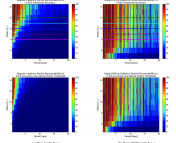Andrew Bowen is a rising junior studying physics and astronomy at Northwestern University. He performed this research as part of the 2018 REU program at Northwestern under the supervision of Dr. Aaron Geller. He plans to present this research at January AAS.
The new Large Synoptic Survey Telescope (LSST) will be able to survey millions of binary star systems when it becomes operational in 2020. With this state-of-the-art telescope comes a new ‘y’ filter, in addition to the ‘ugriz’ filters used in earlier telescopes. Filters are important for telescopes because they allow only certain wavelengths of light to pass through. These specific wavelengths allow us to study different characteristics of a star.

This figure shows the SDSS/2MASS filters (blue) and other filter systems’ (red) limb-darkening coefficients as a function of wavelength. The fit function is a spline we are using to find the value for the y-band (~920-1040nm).
However, for this new ‘y’ filter used in the LSST, there are no limb-darkening coefficients. A limb-darkening coefficient is a number which accounts for differences in brightness of a star at the center versus the edges. In reality, stars are not 2-D projections on the plane of the sky, but are instead 3-D objects. In other words, these limb-darkening coefficients account for the fact that stars (like everything else in space) are three-dimensional.
To find these limb-darkening coefficients, we interpolated from coefficients from otherF filters close to the y-band. More simply, we took an educated guess to find these new limb-darkening coefficients.
We will use these coefficients to simulate LSST observations more accurately. Eventually we will try to find the optimal cadence for LSST to detect and identify eclipsing binary stars.
If you are an undergraduate that took part in an REU this summer and would like to share your research on Astrobites, please contact us at [email protected]!

